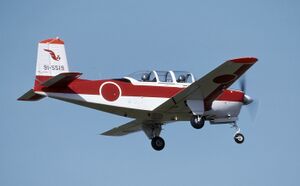Engineering:Fuji T-3
| T-3 | |
|---|---|

| |
| Fuji T-3 | |
| Role | Primary trainer |
| Manufacturer | Fuji Heavy Industries |
| First flight | 1978 |
| Status | Active |
| Primary user | Japan Air Self Defense Force |
| Produced | 1978-1982 |
| Number built | 50 |
| Developed from | Fuji KM-2 |
| Developed into | Fuji T-7 |
The Fuji T-3 is a primary military trainer aircraft used by the Japan Air Self Defense Force, manufactured by Fuji Heavy Industries. Its first flight was in 1978. In the course of its service life, 50 units were produced. It is being replaced by the Fuji T-7.
Development
The KM-2B was a further development of the Fuji KM-2 (itself a four-seat development of the T-34 Mentor with a more powerful engine) for use as a primary trainer for the Japan Air Self-Defense Force (JASDF). It combined the structure and engine of the KM-2 with the tandem cockpit of the T-34 Mentor. Its first flight was on 17 January 1978.[1] Fifty were purchased by the JASDF as the Fuji T-3, and production continued until 1982.[2]
Operational history
The Fuji T-3 served with the 11 and 12 Hiko-Kyoikudan of the JASDF. It is currently being replaced with the Fuji T-7, a turboprop variant of the T-3.[3] with a 400 shp (300 kW) Allison 250 engine.
Operators
 Japan
Japan- Japan Air Self-Defense Force
Specifications (T-3)
Data from Jane's Aircraft Recognition Guide, Jane's All the World's Aircraft, 1976-1977 [4][5]
General characteristics
- Crew: 2
- Length: 8.04 m (26 ft 5 in)
- Wingspan: 10 m (32 ft 10 in)
- Height: 3.02 m (9 ft 11 in)
- Wing area: 16.5 m2 (178 sq ft)
- Airfoil: root: NACA 23016.5; tip: NACA 23012[6]
- Empty weight: 1,120 kg (2,469 lb)
- Max takeoff weight: 1,510 kg (3,329 lb)
- Powerplant: 1 × Lycoming IGSO-480 6-cylinder horizontally opposed air-cooled piston engine, 254 kW (341 hp)
- Propellers: 3-bladed constant-speed propeller
Performance
- Maximum speed: 377 km/h (234 mph, 204 kn) at 4,875 m (15,994 ft)
- Cruise speed: 254 km/h (158 mph, 137 kn) at 2,440 m (8,005 ft)
- Never exceed speed: 413 km/h (257 mph, 223 kn)
- Range: 1,038 km (645 mi, 560 nmi)
- Service ceiling: 8,170 m (26,800 ft)
- Rate of climb: 7.7 m/s (1,520 ft/min)
- Wing loading: 91.5 kg/m2 (18.7 lb/sq ft)
See also
Related development
Related lists
References
- ↑ Donald, David, ed (1996). Encyclopedia of World Military Aircraft. London: Aerospace Publishing. ISBN 1-874023-95-6.
- ↑ Donald, David, ed (1997). The Encyclopedia of World Aircraft. London: Aerospace Publishing. ISBN 1-85605-375-X.
- ↑ Taylor, M J H, ed (1999). Brassey's World Aircraft & Systems Directory 1999/2000 Edition. London: Brassey's. ISBN 1-85753-245-7.
- ↑ Rendall, David (1995). Jane's Aircraft Recognition Guide. Glasgow, UK: HarperCollinsPublishers. p. 505. ISBN 0-00-470980-2. https://archive.org/details/janesaircraftrec0000rend/page/505.
- ↑ Taylor, JWR, ed (1976). Jane's All the World's Aircraft, 1976-1977. London: Macdonald and Jane's. ISBN 0-354-00538-3.
- ↑ Lednicer, David. "The Incomplete Guide to Airfoil Usage". https://m-selig.ae.illinois.edu/ads/aircraft.html. Retrieved 16 April 2019.
 |

